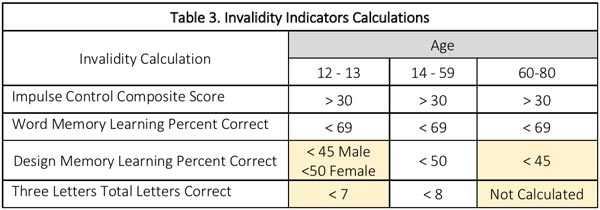ImPACT Version 4 Invalidity Indicators
ImPACT Version 4 provides a validity index designed to aid in identifying invalid baseline examinations. Validity cut-offs were calculated by identifying the point at which 5% of the test-takers fell below the sum total of all of the indicators, based on their age, gender, and input device. See Table 3.
If any of these criteria are reached for a given baseline test, the ImPACT Version 4 report will automatically print a sentence that identifies the test results as being
“invalid”. If this is the case, the test administrator is encouraged to repeat the baseline exam, only after discussing the test results with the individual and identifying the reasons for the invalid test (e.g. difficulty understanding one or more of the modules, not taking the test seriously, etc.).

What are the Most Common Causes of Test Invalidity during Baseline?#
- Failure to properly read directions due to a reading disability or carelessness.
- Attention deficit disorder and/or hyperactivity (ADD or ADHD).
- Excessive fatigue (e.g. completion of testing after vigorous exercise).
- “Horseplay” which can occur when individuals are not properly supervised or are placed too close together in a room.
- Left-right confusion which often is evidenced by scores about 20 on the Impulse Control composite and is usually the result of the reversal of left and right on the X’s and O’s distracter task.
- Intentional poor performance to attempt to set a low baseline standard.
- Other neurological and psychological disorders in which impaired cognitive function is commonly present.
Intentional poor performance on a baseline test#
Intentional poor performance on baseline testing is a topic that garners attention from time to time. Practically speaking, it is not different than any of the other above-listed causes of invalidity of a Baseline test. There has been no consensus on the frequency of occurrence of this phenomenon, or mechanisms for identifying individuals who engage in this practice. Version 4 contains validity indices that can be used to identify atypically low scores. If a test taker is suspected to intentionally underperform on the test, the proctor should use that opportunity to educate the test taker about the importance of performing to the best of his or her ability and
repeat the test.
Not the solution you are looking for?
Please check other articles or open a support ticket.